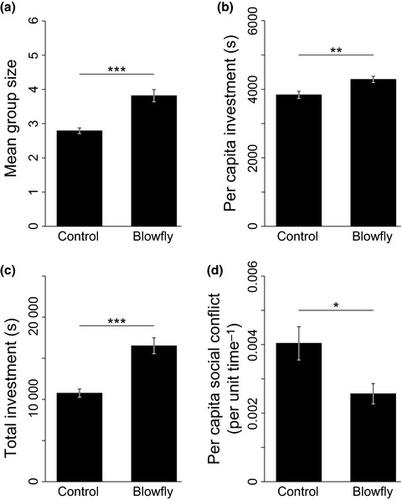当前位置:
X-MOL 学术
›
Ecol. Lett.
›
论文详情
Our official English website, www.x-mol.net, welcomes your
feedback! (Note: you will need to create a separate account there.)
A chemically triggered transition from conflict to cooperation in burying beetles.
Ecology Letters ( IF 7.6 ) Pub Date : 2020-01-07 , DOI: 10.1111/ele.13445 Bo-Fei Chen,Mark Liu,Dustin R Rubenstein,Syuan-Jyun Sun,Jian-Nan Liu,Yu-Heng Lin,Sheng-Feng Shen
Ecology Letters ( IF 7.6 ) Pub Date : 2020-01-07 , DOI: 10.1111/ele.13445 Bo-Fei Chen,Mark Liu,Dustin R Rubenstein,Syuan-Jyun Sun,Jian-Nan Liu,Yu-Heng Lin,Sheng-Feng Shen

|
Although interspecific competition has long been recognised as a major driver of trait divergence and adaptive evolution, relatively little effort has focused on how it influences the evolution of intraspecific cooperation. Here we identify the mechanism by which the perceived pressure of interspecific competition influences the transition from intraspecific conflict to cooperation in a facultative cooperatively breeding species, the Asian burying beetle Nicrophorus nepalensis. We not only found that beetles are more cooperative at carcasses when blowfly maggots have begun to digest the tissue, but that this social cooperation appears to be triggered by a single chemical cue - dimethyl disulfide (DMDS) - emitted from carcasses consumed by blowflies, but not from control carcasses lacking blowflies. Our results provide experimental evidence that interspecific competition promotes the transition from intraspecific conflict to cooperation in N. nepalensis via a surprisingly simple social chemical cue that is a reliable indicator of resource competition between species.
中文翻译:

从化学原理上引发了从冲突过渡到埋葬甲虫的合作。
尽管种间竞争早已被公认为是性状差异和适应性进化的主要驱动力,但相对较少的努力集中于它如何影响种内合作的进化。在这里,我们确定了一种机制,在这种机制下,种间竞争的感知压力影响了在内部合作繁殖的物种亚洲埋藏甲虫Nicrophorus nepalensis中从种内冲突到合作的过渡。我们不仅发现当blow蝇blow开始消化组织时,甲虫在cas体上更具协作性,而且这种社会合作似乎是由从blow虫消耗的car体中散发出的单一化学提示-二甲基二硫(DMDS)触发的,但是而不是缺少蝇的对照car体。
更新日期:2020-01-08
中文翻译:

从化学原理上引发了从冲突过渡到埋葬甲虫的合作。
尽管种间竞争早已被公认为是性状差异和适应性进化的主要驱动力,但相对较少的努力集中于它如何影响种内合作的进化。在这里,我们确定了一种机制,在这种机制下,种间竞争的感知压力影响了在内部合作繁殖的物种亚洲埋藏甲虫Nicrophorus nepalensis中从种内冲突到合作的过渡。我们不仅发现当blow蝇blow开始消化组织时,甲虫在cas体上更具协作性,而且这种社会合作似乎是由从blow虫消耗的car体中散发出的单一化学提示-二甲基二硫(DMDS)触发的,但是而不是缺少蝇的对照car体。











































 京公网安备 11010802027423号
京公网安备 11010802027423号